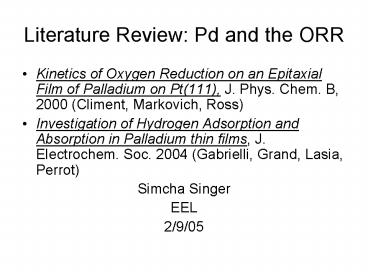Literature Review: Pd and the ORR - PowerPoint PPT Presentation
1 / 18
Title:
Literature Review: Pd and the ORR
Description:
Investigation of Hydrogen Adsorption and Absorption in Palladium thin films, J. Electrochem. ... Absorption current swallows adsorption current. 10 ML Pd Film ... – PowerPoint PPT presentation
Number of Views:152
Avg rating:3.0/5.0
Title: Literature Review: Pd and the ORR
1
Literature Review Pd and the ORR
- Kinetics of Oxygen Reduction on an Epitaxial Film
of Palladium on Pt(111), J. Phys. Chem. B, 2000
(Climent, Markovich, Ross) - Investigation of Hydrogen Adsorption and
Absorption in Palladium thin films, J.
Electrochem. Soc. 2004 (Gabrielli, Grand, Lasia,
Perrot) - Simcha Singer
- EEL
- 2/9/05
2
Literature CV of Pd in N2
- What is occuring???
- Hydrogen Desorption Hads?He-
- Oxide Formation (PdO is formed)
H2O?Oads2H2e- - (O2-?O or Pd?Pd2)
- Oxide reduction (PdO reduced) Oads2H2e- ?H2O
- (O ? O2-)
- 4. Hydrogen Adsorption and Absorption He- ?
Hads
3
Paper 1 Epitaxial Pd Film on Pt
- Best Catalysts for ORR are Pt group metals
RhltPdltPt - Kinetics also affected by adsorbed spectator
anions in electrolyte - Not many studies on Pd single crystal electrodes
b/c Pd absorbs hydrogen and disorders single
crystal surface - Deposited epitaxial layer of Pd on Pt(111)
surface instead of bulk single crystal Pd (111)
which absorbs H2
4
Technique/Film Structure
- Mounted Pt(111) surface in RDE config. and
deposited 1 ML of Pd by cycling electrode in 10-5
M PdO in 0.05 M H2SO4 at 20 mV/s - For Pd films gt 10 ML H2 is absorbed
- For Pd films lt 5 ML, H2 isnt absorbed, possibly
b/c lattice constants of Pt and Pd differ by 0.8
and strain of 1st layer prevents outer layers
from expanding and letting in H2
5
CV in H2SO4 and HClO4
- Pt (dashed line) 1st peaks are H ads, 2nd are
anion ads (HSO4- and OH-) - For Pd ML In H2SO4 the peaks merge
- In HClO4 anion peak shifts negative (100 mV)
relative to Pt in same electrolyte and double
peak in Hads region
6
CV in H2SO4 and HClO4
- Interpretation Anion adsorption peaks merging
(H2SO4)/shifting(HClO4) indicates stronger
interactions of anions with Pd ML than Pt, due to
lower potential of zero charge for Pd - PZC is when sm ss0 (excess charge on electrode
and in solution) - They claim multiple Hads peaks due to defect
sites when forming layer
7
ORR
- ORR can either proceed as O24H4e- ?2H2O
- or O22H2e- ?H2O2
- In H2SO4 on Pt ORR proceeds as 4 e- process above
0.2 V vs RHE - Pd film ORR inhibited below 0.65 V due to
adsorbed HSO4- - Adsorbed HSO4- inhibits initial O2 ads as well as
formation of Pd pairs which allow breaking O2
bonds, proceeds as 2e- process
8
ORR cont.
- In HClO4 ORR is not as greatly inhibited as in
H2SO4 b/c OHads occurs at 0.65 V - Below 0.65 V, on positive sweep, theres no anion
adsortion, so performance is same as Pt(111) ?
Full 4 electron process
9
K-L Plots
- As expected, lower intercepts for HClO4
corresponding to higher kinetic currents - These plots may serve as good comparison for our
research
10
Tafel Plots
- Lower Tafel slopes for HClO4
- Constant slope ? same rate determining step
- Higher Tafel slope for H2SO4
- Changes from 120 to 400 mV/decade
- They propose its due to rds changing from charge
transfer to adsorption of oxygen (b/c its
inhibited by anion adsorption)
11
Conclusions
- Above 0.8 V vs RHE, kinetic currents are 2 times
higher in HClO4 than in H2SO4 - Due to lower pzc of bisulfate anion, which is due
to similarity in its structure with Pt and Pd - Adsoption inhibition of ORR is higher on Pd film
than on Pt single crystal alone - My question is what about oxide
formation/reduction? They didnt mention it
12
Paper 2 Hydrogen Adsorption and Absorption on
Pd Thin Films
- Used 0.1 M H2SO4 electrolyte for RDE
- Electrodeposited Pd thin film on Au electrodes,
thicknesses 10 ML-10 um - Used bulk Pd foils for cpmparison, cleaned
surface of oxides by applying a negative
potential vs RHE - Roughness factor of thin films varied from 1 to
2.7 with thickness of layer
13
SEM image of Pd Film
14
CV of Bulk and thin film Pd
- Hydrogen desorption extends to more positive
potentials on bulk Pd due to diffusion from bulk - On bulk Pd, adsorption and absorption peaks are
indistinguishable - Peaks at .155 and .265 correspond to adsorption
while more negative peaks are absorption
15
More CV data
- Increasing Anodic limit causes PdO reduction peak
to shift to more negative values
16
Changing Layer Thickness
- Plot flipped to positive side
- As thickness increases, absorption current
increases - Absorption current swallows adsorption current
17
10 ML Pd Film
- H adsorption starts at 0.4 V (peak at 0.27 V)
- H absorption starts at 0.132 V (peak at 0.04 V)
- H evolution starts at 0.025 V
- Integrating charge indicates more than a single
adsorbed H layer
18
Conclusions
- On bulk Pd (gt4000 ML, gt1.6 um), H adsorption and
absorption begin at same potential (CV of wire) - On very thin films, 10 ML, adsorption,
absorption and evolution peaks are separated
(fig. 6) - On intermediate thicknesses, absorption and
evolution are not separated on CV (fig. 4)































